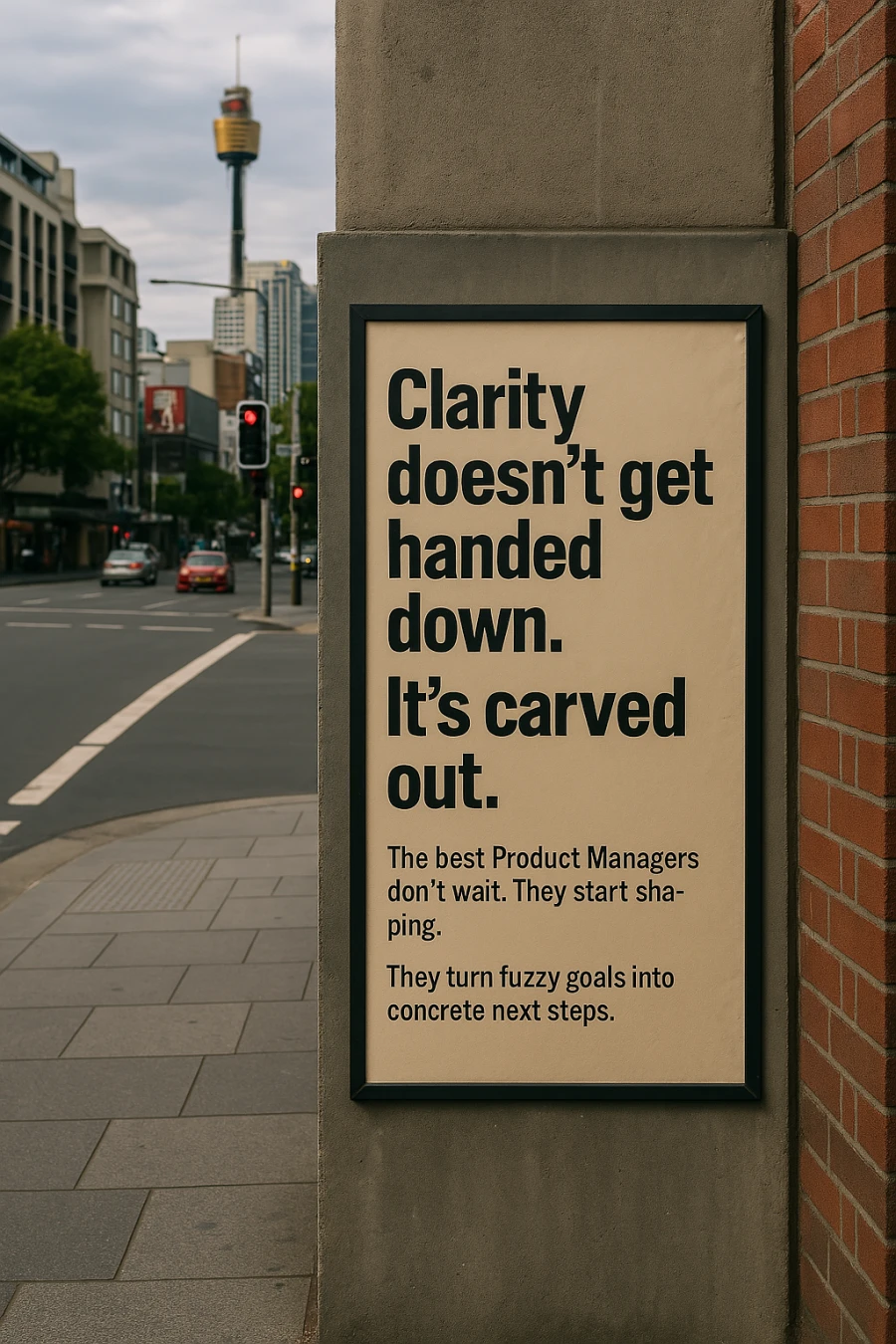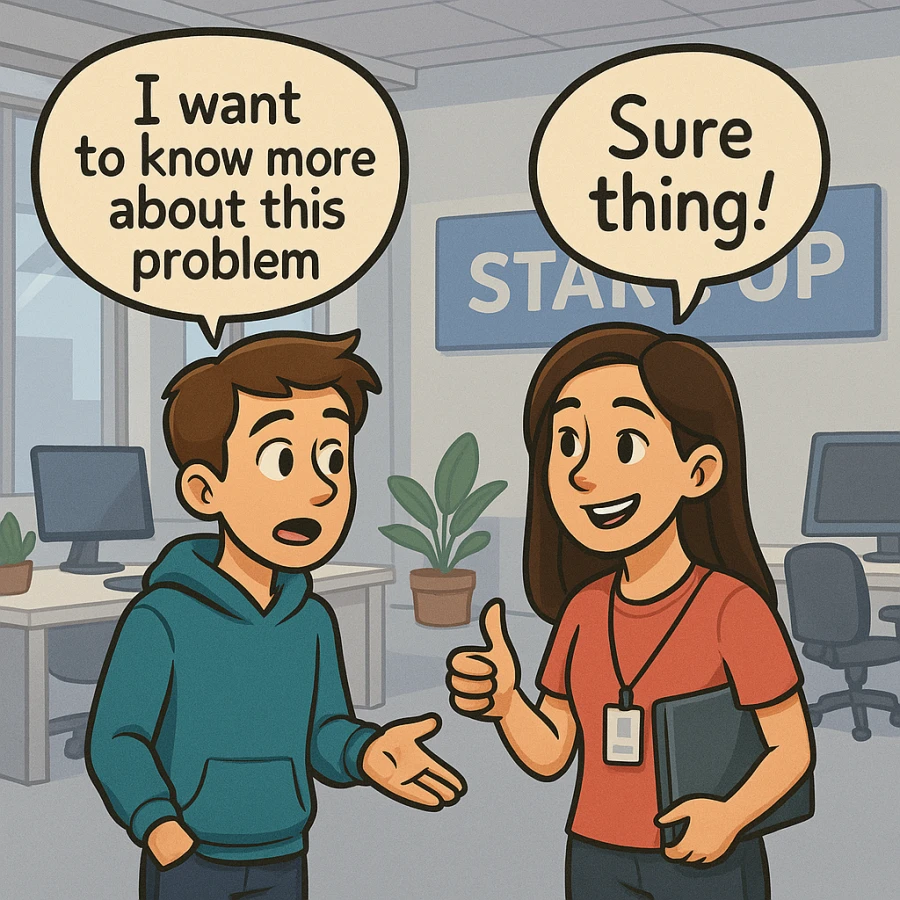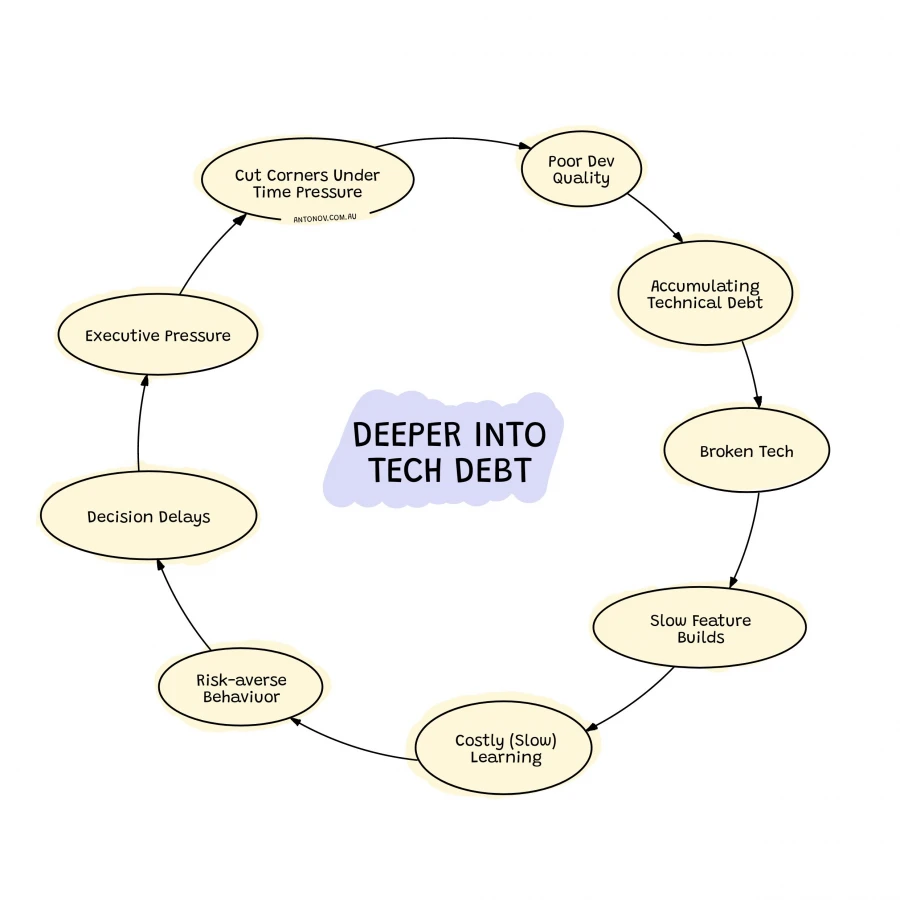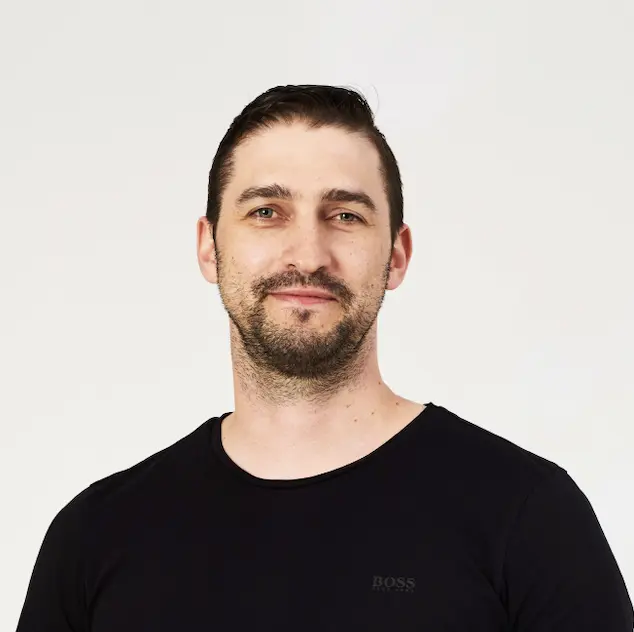I'm a father of three from Sydney, a Product Director and a Product Coach. I write about product management and run the Product Manager community.
Subscribe to receive digest emails (1 per month).
Info
Posts with Product Management tag.
-
Leave PMs alone!
When you're part of a good 1:1 product management community, it keeps you away from quietly losing your marbles.
One of the most common topics that surfaces is the time wasted managing expectations ... Read more -
Vibe Coding
Peter Drucker once said, “Doing the right thing - even if not perfectly executed - is far superior to perfectly executing the wrong thing.”
He was right but most of the time you can't tell if you're ... Read more -
Get comfortable being uncomfortable
When a Product Manager gets comfortable with predictability - hitting deadlines and running smooth sprints - they sometimes find themselves locked into what's safe, just keeping the engine running and... Read more -
The best PMs are detail-oriented.
Even when under pressure to start executing, they still do the work in the background to make sense of it. If it doesn't, they bring it up in a non-confronting, logical way.
I've seen big decisions being reversed because of that, saving the company tens of thousands of dollars that could have been lost by going in the wrong direction where the maths does not stack up.
Hold on to these PMs. -
The best way to kill your product instincts is to outsource your customer research.
When you get answers neatly packaged in a fancy PDF with cool graphs and slick design, you feel good about it. It looks like the hardest part has been done, and you just need to look at the numbers and insights. On the surface.
As you go through the research prepared by someone else, you realise you only gain surface-level knowledge of the space.
Real research is about developing a good understanding of what your customers are experiencing - the small problems they face, along with all the nuances and frustrations.
You have to speak to them. No surveys or written responses will give you true insight into their challenges.
When you outsource research, someone else builds that understanding - not you.
Your product instincts start to fade over time. -
The best PMs demand clarity. They don't rush ahead until the problem, the why and the how are nailed down. Then they spread it. With sharp words. With tight updates. With documents people actually read.
-
Block 1 hour a week to watch support tickets or user interviews.
Don't delegate it. Don't skim AI summaries. Watch raw moments - confusion, frustration, workarounds, and aha moments. Then write down one insight. Just one.
That habit alone will sharpen your product instincts faster than any strategy workshop. -
Some bets feel smart at the time. You do the homework. You check the trade-offs. You pick the direction that feels right.
But then you learn more. You zoom out. You see something you missed. And suddenly, the smart bet looks stupid. It's not failure, though. Bad bets are part of good decision-making.
No team gets them all right. What matters is spotting the miss early, learning from it and moving on. Letting ego or sunk cost trap you in a bad call is far worse than making it in the first place. Just build the culture where you can recover fast from them. Because clarity comes after the leap. Not before. -
Hiring a Product Manager? Features don't tell you how they think. Trade-offs do.
“Design me a feature” is lazy. It rewards idea factories. It skips the messy bit. The hard decisions, the real trade-offs, the collaboration across disciplines. And most of the time, it's work for a designer, not a PM.
Great PMs don't need to be idea machines. They need to place good bets. People who know when to push, when to pause.
Want to spot a great PM? Ask about their past work. Zoom in on the messy bit. What changed because of them? What did they push for, protect or reshape? Where did they tilt the odds instead of following the script?
The best answers come from the hard parts - the tension and the feedback loops. The trade-offs and the moments when things weren't obvious. When the path wasn't clear but they still found a way forward. That's where the gold is. Not in ideas but in impact.
Real product work looks like wrestling with constraints, aligning the team, managing pressure and holding context across functions. It's pushing through ambiguity without defaulting to consensus. It's saying no more than yes. And it's knowing which bets matter and which don't.
PMs don't just ship features. They see through noise. They narrow scope. They frame decisions. Don't test them on what they can dream up. Test them on what they've already done. -
Stop hiring Product Managers to write tickets.
Start hiring them to shape the future.
Too many teams confuse product delivery with product leadership. They fill PM roles with people who keep the board clean, manage standups and translate features into tidy Jira tickets. It looks like progress. But all you've done is create a high-functioning to-do list. That's not product management. That's task management.
Real product managers don't just move work forward - they decide what work matters. They ask the harder questions:- What should we bet on?
- What problem are we solving?
- What's the outcome we're driving?
They think like GMs. They live in the tension between customer problems and commercial outcomes. They know the metrics. They sit in sales calls. They challenge assumptions. They protect focus. They say "no" more than they say "yes".
If all your PM is doing is cleaning up Jira, you don't need another one. You need a BA. Or maybe a project manager. But don't pretend it's product leadership.
Delivery is a muscle. Strategy is a brain. Stop building muscle at the cost of brains. -
Some execs get product-led growth wrong.
They confuse it for a team chart shift. Treat the product team like glorified BAs. Let sales keep owning the funnel.
But product-led growth isn't a structural tweak. It's a go-to-market motion. Product isn't there to “gather requirements” - it drives the entire engine. From first click to expansion. Sales doesn't disappear but it stops being the gate. It becomes a guide.
Leave product out of the funnel and you're not doing PLG. Putting lipstick on a sales funnel. -
Advisors don't build your product. Your team does.
Startups often chase external wisdom: big-name advisors, mentors or consultants. Feels smart. Feels strategic. But what gets ignored is the gold sitting right inside the company: the frontline team. The people closest to the work. The ones who spot real problems before they hit dashboards.
Most companies skip this step. They hire an advisor to fix product strategy, while the product team quietly shakes their heads. They run a culture workshop, while the team whispers: “We've been saying this for months”
The fix isn't more voices. It's better loops.
Build internal insight loops before you chase external ones. Create a rhythm of feedback, reflection and iteration...led by the people doing the work. Document the pain points. Invite challenge. Turn silence into signal. Once that's running strong, then (and only then) bring in outside help to sharpen, not replace, your instincts.
Your team knows more than your boardroom. Listen there first. -
AI won't replace Product Managers. But it will expose the ones who never should've had the job.
PMs who survive on vibe, templates and Jira tickets are already being outpaced. AI does what they do. But faster, cheaper and with better spelling.
AI is forcing PMs to evolve from backlog babysitters into strategic operators.
No more hiding behind status updates or pretending roadmapping is vision. AI writes specs. It cleans up research notes. It summarises meetings and drafts Jira tickets before the devs have logged off. If that's your whole job, start sweating.
But if you're the kind of PM who shapes bets, sharpens focus and asks better questions -you're not replaceable. You're rare.
Only sharp PMs know which bets to place, when to double down and when to walk away.
AI won't take your job. But a better PM using AI will.

-
Product-market fit doesn't exist.
It's a myth we tell ourselves to feel like we're on the right track.
“Agile” suffered the same fate (at least there's the agile manifesto that exists). Started as a working philosophy, ended up a bingo word. Everyone says they have PMF. No one can show you where it lives. They just point to a vibe. Some traction. A few good months. A round that closed fast.
“We've got it!”
Based on what? Revenue spikes? Retention curves? Activation rates? NPS? Shorter sales cycles? Word of mouth? A gut feel after a good week? A bit of everything and nothing concrete?
The phrase has become a catch-all. Founders claim it when growth feels easier than usual. Investors expect it before writing a check. But there's no standard. No scoreboard. Every product is different. Every market reacts in its own way.
What looks like PMF for one company might be a dead end for another.
Product-market fit isn't something you find. It's something you feel.
And sometimes, you just hope you're right. -
Product Managers wait for clarity that never arrives.
They expect the strategy doc to have the answers. But nothing lands. Just more PowerPoint slides.
Because the higher up you go, the blurrier it gets. Goals get loftier. Language gets vaguer. No one wants to be wrong. So they delay, they decorate confusion with buzzwords. It feels smart but it isn't clear.
The best Product Managers don't wait. They start shaping. They turn fuzzy goals into concrete next steps. They don't chase alignment. They chase decisions. They poke holes (even when it creates discomfort). They write the draft no one asked for. They map the fog, not run from it.
Because anyone can follow a plan. But great Product Managers can make one. They stop asking “What's the direction?” and start saying “Here's what I'm seeing - poke holes in it”

-
Some tech teams think their job starts when the requirements arrive.
But that mindset turns them into delivery machines - waiting for Jira tickets like orders at a café. The real value isn't in ticking off tasks. It's in shaping them. Working with product managers, not for them.
Because PMs aren't there to write task lists. They're commercial thinkers. They're shaping strategy, pushing customer insight, and holding the big picture. They don't need followers. They need partners.
Do less: waiting for answers.
Do more: collaborating to understand the “why.”
That's how you build better products - and better teams.

-
Validation Comes After Launch
You can't validate a product with opinions.
People love to be nice. They'll tell you what you want to hear. “I'd buy that.” “Sounds awesome.” “I'd totally use it.” They're not lying to be cruel. They'... Read more -
Like a snowball rolling downhill, technology debt simply gets bigger.
Cutting corners and patching things up work for a while. But eventually the codebase becomes a mess. Features take longer to build, and bugs pile up. The team becomes nervous about making changes. This triggers leadership demands speed, trapping everyone in a difficult cycle to break.

-
There are two types of product teams - the slow-learning and the fast-learning.
The slow-learning team wants to deliver. They manage projects, write tickets, attend internal meetings and ask colleagues for design feedback. They mostly care about delivery and managing expectations.
The fast-learning team wants to learn. They talk to customers, read market news, push hacky code to production, and sometimes break things. They embrace ambiguity, but they learn fast.
The difference? The slow-learning team builds products for their bosses, and the fast-learning team builds products customers actually need.
Shift your focus. The best products come from deep insight, not just efficient delivery. -
When your team isn't experimenting enough, it's most likely due to experiments taking too long to build, track and measure.
But every missed experiment is a missed opportunity. Insights go untapped. Ideas remain untested. Innovation stalls.
If the bottleneck is tech, hack it. Find workarounds even at the cost of degrading user experience but push forward.
Constraints spark the best solutions.
Feel free to reach out: [email protected].
